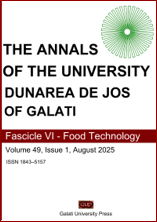An overview on extruded rice analogues produced using hot extrusion processing
Abstract
The development of extruded rice analogues using hot extrusion processing has gained significant attention due to its potential to address food security and meet consumer demands for functional and nutritious foods. This review provides a comprehensive overview of the key aspects involved in the production and characterization of extruded rice analogues. The ingredients used in the extrusion process are discussed, highlighting their roles in determining the final product properties. The thermal and pasting properties are reviewed, emphasizing their product stability and functionality implications. The texture profiles, including hardness in uncooked extruded rice analogues and texture changes upon cooking, are critically reported. Furthermore, cooking behavior, nutritional value, and sensory properties of extruded rice analogues are summarized to assess their acceptability and suitability for diverse consumer groups. The review also explores market opportunities and challenges, identifying pathways to improve product development and commercialization. In conclusion, this review focuses on the prospect of extruded rice analogues being a sustainable and approach to diversification of food product.


